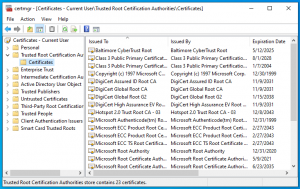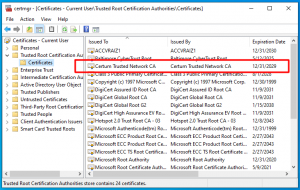Windows trusting many more Root Authorities than certmgr shows
This baffled me for a while: I used certmgr to see if a Windows 10 machine had a root certificate that was needed to certify a certain digital signature, and it wasn’t listed. But then the signature was validated. And not only that, the root certificate was suddenly present in certmgr. Huh?
Here’s a quick demonstration. This is the “before” screenshot of the Certificate Manager window (click to enlarge):
Looking at the registry, I found 11 certificates in HKEY_LOCAL_MACHINE\SOFTWARE\Microsoft\SystemCertificates\AuthRoot\Certificates\ and 12 certificates in HKEY_LOCAL_MACHINE\SOFTWARE\Microsoft\SystemCertificates\ROOT\Certificates\, so it matches exactly certmgr’s view of 23 root certificates.
And so I had a .cab file with a certificate that requires Certum’s root certificate for validation. Clear from the screenshot above, it’s not installed.
Then I right-clicked that .cab file, selected Properties, then the “Digital Signature Tab”, selected the certificate and clicked Details, and boom! A new root certificate was automatically installed (click to enlarge):
And suddenly there are 12 certificates in the AuthRoot part of the registry instead of 11. Magic.
And here’s the behind the scenes of that trick.
Microsoft publishes a Certificate Trust List (CTL), which every computer downloads automatially every now and then (once a week, typically). It contains the list of root authorities that the computer should trust, however apparently they are imported into the registry only as needed. This page describes the concept of CTL in general.
I don’t know where this is stored on the disk, however one can download the list and create an .sst file, which opens certmgr when double-clicked. That lists all certificates of the downloaded CTL. 425 of them, as of May 2021, including Certum of course:
> certutil -generateSSTFromWU auth.sst
So it seems like Windows installs certificates from the CRL as necessary to validate certificate chains. This includes the GUI for examining certificates, verifying with signtool, as well as requiring the certificate for something actually useful.
There’s also a utility called CTLInfo out there, which I haven’t tried. It apparently displays the CTL currently loaded in the system, but I haven’t tried it out.
There’s another post in Stackexchange on this matter.
Besides, I’ve written a general post on certificates, if all this sounded like Chinese.

